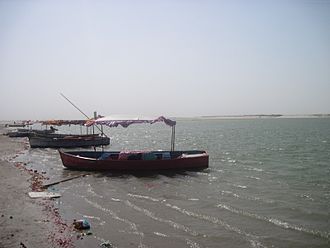Ghaghara

Ghaghara, also called Karnali (Hindi: घाघरा; Ghāghrā [ˈɡʱɑːɡrɑː]; Nepali: कर्णाली; Karṇālī [kʌrˈnɑːliː]; Chinese: 加格拉河; Jiāgélāhé [t͡ɕi̯ákɤ̌láxɤ̌]) is a perennial trans-boundary river originating on the Tibetan Plateau near Lake Manasarovar. It cuts through the Himalayas in Nepal and joins the Sharda River at Brahmaghat in India. Together they form the Ghaghara River, a major left bank tributary of the Ganges. With a length of 507 kilometres (315 mi) it is the longest river in Nepal. The total length of Ghaghara River up to its confluence with the Ganges at Revelganj in Bihar is 1,080 kilometres (670 mi).[1] It is the largest tributary of the Ganges by volume and the second longest tributary of the Ganges by length after Yamuna.
Lower Ghaghara is also known as Sarayu river and finds mention in Ramayana. Ayodhya is situated on its right bank. The Ghaghara was also the site of the battle between Amin Khan Aitigin and Tughral Tughan Khan.[2]
It rises in the southern slopes of the Himalayas in Tibet, in the glaciers of Mapchachungo, at an elevation of about 3,962 metres (12,999 ft) above sea level. The river flows south through one of the most remote and least explored areas of Nepal as the Karnali River. The 202-kilometre (126 mi) Seti River drains the western part of the catchment and joins the Karnali River in Doti District north of Dundras hill. Another tributary, the 264-kilometre (164 mi) long Bheri, rises in the western part of Dhaulagiri Himalaya and drains the eastern part of the catchment, meeting the Karnali near Kuineghat in Surkhet.[3]
Cutting southward across the Siwalik Hills, it splits into two branches, the Geruwa on the left and Kauriala on the right near Chisapani to rejoin south of the Indian border and form the proper Ghaghara. Other tributaries originating in Nepal are the West Rapti, the Kali (or Mahakali) and the little Gandak. It flows southeast through Uttar Pradesh and Bihar states to join the Ganges downstream of the town of Chhapra, after a course of 1,080 kilometres (670 mi). Sarayu river is stated to be synonymous with the modern Ghaghara river or as a tributary of it.
Karnali River exposes the oldest part of the Sivalik Hills of Nepal. The remnant magnetization of siltstones and sandstones in this group suggests a depositional age of between 16 million and 5.2 million years.
